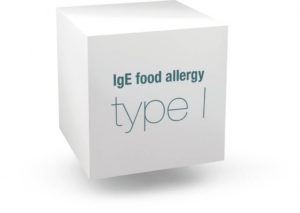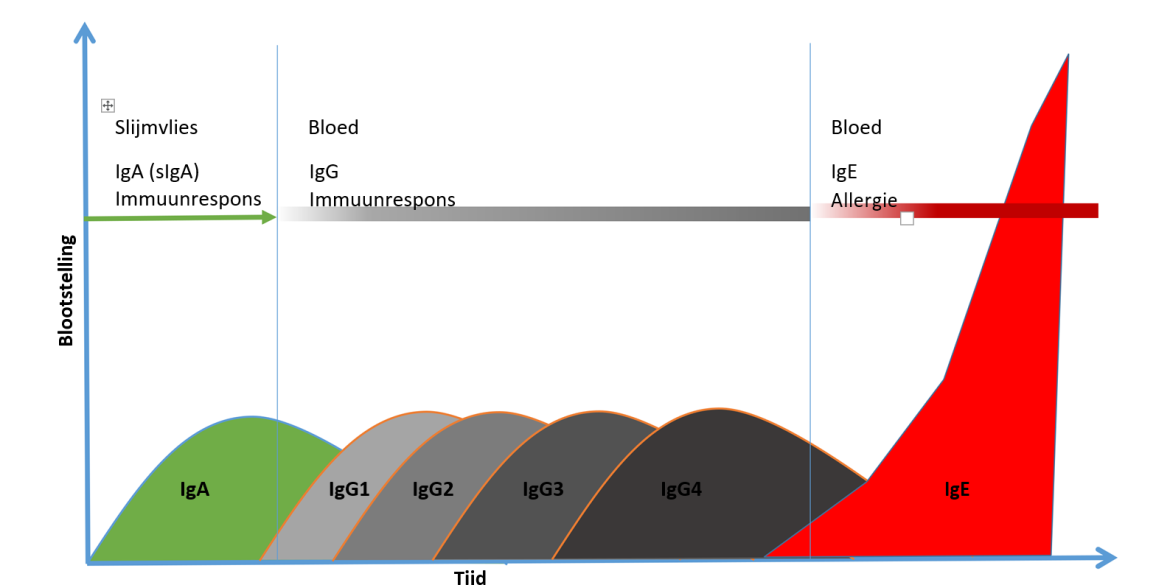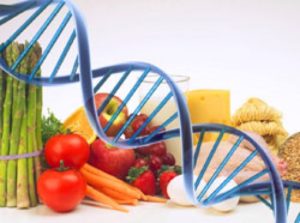If you suffer from a food allergy, you often notice it right away. A swollen throat, fainting and other serious complications. Food allergy is measured by determining the IgE antibodies. This form of allergy is much less common than food intolerance.
Food intolerance is often much more difficult to detect because it causes symptoms hours or even days after eating the food. This is examined by measuring the IgG antibodies. IgG antibodies cause low-grade inflammation, which affects your condition and health in the long term.
And what about your genetic predisposition? Which nutrients can you convert well for use and which ones not? This can only be discovered through a DNA test.
food intolerance it is difficult to find out which food causes your symptoms. This is because the complaints become chronic. The symptoms only appear hours, or even days, after eating the food you are allergic to. This is also called a delayed food allergy. In the case of IgG food intolerance, your immune system reacts to - normally - harmless foods. This can cause low-grade inflammation. These can lead to chronic symptoms and have a major impact on your health.
What's the cause?
Undigested proteins enter your bloodstream. Your immune system sees these proteins as foreign substances and launches an attack with IgG antibodies. This causes inflammatory reactions with a negative impact on your health and performance. Low grade inflammation is completely different from "normal" inflammation. Normal acute inflammation is good for your body because it clears an infection. Acute, perceptible inflammations are very different from low-grade inflammations. These are often not easy to solve and we often don't even notice that they are there. Low-grade inflammations, which are often chronic, are not healing but actually pathogenic. They can damage the cells and therefore the tissues. Our immune system, which goes into action during acute inflammation, also goes to work now but continues to do so because the inflammation is chronic. Eventually your immune system becomes overworked and the result can be that the body attacks itself.
What is the difference between food intolerances?


An IgG food allergy, also called food intolerance, should not be confused with a standard food allergy (type 1). If you have a type 1 allergy, your immune system produces IgE antibodies. These antibodies lead to an immediate allergic reaction. These allergies are much rarer. If you have this type of allergy, you are usually already familiar with it, because this type of allergy is very acute and very severe.
In addition to this real food allergy, there may also be food intolerance, the nutrients you cannot tolerate we call your trigger foods.
The constant intake of your 'trigger foods' can then cause chronic inflammation and thus increase the level of TNF-alpha. TNF-alpha is a protein that is overactive when you have an autoimmune disease. Increased TNF-alpha levels cause the immune system to attack your body's own cells and damage your immune system.
This can block the insulin receptor and you can even become insensitive to the hormone insulin: called insulin resistance. The result is that you store fat and get fat. This is also the accelerator in our aging process and has very negative consequences for our health. Because of this, carbohydrates cannot be fully utilized and are not transported to the muscles, which also negatively influences sports performance.
The substances created after an IgG reaction can bind to red blood cells and cause them to clot. This leaves less room for oxygen in the red blood cells, which means that the muscles receive less oxygen and your performance deteriorates.
How do you find out?
The "What Can I Eat" blood test helps you find the nutrients that are good for you and determine your 'trigger foods'. To identify these trigger foods, the lab analyzes your serum blood and determines the presence of specific IgG antibodies in a large number of different foods
With the Watmagiketen test you find out to which foods you are intolerant. Only the Watmagiketen test +IgE measures whether you also have real acute allergies. But which IgE food intolerance this is, for that you have to do follow-up research.
IgG measures triggers of low-grade inflammation
With the What Can I Eat test, you can find out if a food intolerance could be the cause of your symptoms. Through innovative and extensive blood analysis, the food intolerance test identifies IgG antibodies quickly and accurately. You will receive a personalised nutrient profile with foods you can eat, those you should temporarily avoid and those you should avoid in the long term. By avoiding these trigger foods, inflammation can be reduced or even eliminated altogether so your body can recover.
By carefully planning your diet and avoiding foods you are allergic to, your immune system will improve again.
What's the result?
Avoid the foods you are allergic to and:
- Slim down
- Get more energy
- Make sure you retain less moisture
- Recover faster after training
Measure total IgG or IgG4?
A food allergy is caused by IgE antibodies and a delayed food allergy is caused by IgG antibodies.
IgG antibodies are divided into 4 subclasses, IgG1, IgG2, IgG3 and IgG4. IgG4 is related to type 1 allergy and can be considered the antidote to IgE antibodies.
IgG4 is present in the blood in much lower concentrations than the other subclasses, but higher levels of IgG4 can release histamine, which can cause pseudo allergic reactions especially symptoms in patients with low DAO activity. Therefore, it is better to avoid these foods as well if a high reaction to IgG4 is measured. In pre-screening, IgG total and IgG4 are therefore reported separately, according to this result the follow-up tests are recommended or performed.
This diagram clearly shows how your allergy can develop over time from an IgA allergy to an IgE allergy. In the IgG 3 and IgG 4 phase you can already develop considerable complaints, and such an intolerance does not have to develop into an IgE allergy.

IgE antibodies measure allergy
IgE stands for immunoglobulin E. These antibodies are involved in the defence against parasites and allergic reactions. An increased IgE is therefore seen with an allergic reaction or an infection with parasites.
Immunoglobulins, or antibodies, are proteins produced by immune cells to clear foreign substances and fight infections (viruses, bacteria or parasites). There are five different types of immunoglobulins: IgG, IgM, IgA, IgD and IgE. IgEs help to fight parasites such as worms, among other things. Sometimes the body's defences fail and IgE is produced not only against intruders, but also against harmless substances, also known as allergens, for example grass pollen or cat dander. A person can develop an allergy to such substances. We can also measure the amount of IgE in the blood against a specific allergen, such as IgE against grass pollen, cow's milk, chicken protein, soy, wheat, peanut and fish.
The reference values for IgE are age-related; the IgE content in adults is higher than in children. Furthermore, the reference values depend on the measuring method used. A normal result means that an allergy caused by IgE is unlikely.
If the amount of IgE is increased this may fit the complaints of allergy, but it also happens that the complaints do not (at all) fit the increased IgE result. Therefore, the diagnosis of allergy can only be made on the basis of the complaints, possibly supplemented by the IgE result(s). A highly elevated result can fit hyper IgE syndrome (job syndrome) or an IgE-producing multiple myeloma (e.g. Kahler's disease). In both cases an allergy has to be excluded first.
Allergy desensitization with therapy.
Desensitising is making people insensitive to certain substances. In the case of an allergy, this means making the substance to which you are sensitive insensitive, for example tree and/or grass pollen in the case of hay fever. Desensitization (also called hypo-sensitization, immunotherapy, (allergy) vaccination cure, drop cure or injection cure) is a treatment for certain allergies (tree and grass pollen (hay fever), house dust mite, insect sting (wasp, bee, bumblebee) and sometimes for cat and dog). It fights the cause of the allergy and not only the symptoms as is the case when using medication such as an antihistamine.
 The difference between Gluten intolerance and Coeliaki
The difference between Gluten intolerance and Coeliaki
The Watmagiketen tests measure intolerance to gluten. (IgG against gluten) gluten intolerance. Gluten intolerance is a form of hypersensitivity to gluten that is reversible, by giving the intestines a rest and allowing them to recover. The symptoms caused by food that you can not stand can vary from: gastrointestinal complaints, headaches, obesity and skin diseases.
With celiac disease, the symptoms only get worse as you continue to eat gluten. The test for the coeliac condition measures antibodies against transglutaminase in the blood. Most medical specialists believe that the best test for diagnosing the coeliac condition is a 3-sample blood test:
- transglutaminase (tTG), tissue (IgA) serum
- transglutaminase (tTG), tissue IgG serum
- IgA serum
Celiac disease is more common than previously thought.
More than half of celiac patients do not have with the classic picture of diarrhea. There may also be anemia and decreased bone density.
Celiac disease is a chronic intestinal disease induced by a hypersensitivity to the storage proteins of cereals (gluten). The hypersensitivity particularly concerns the gluten of related species such as wheat, barley and rye, but not oats, rice or corn. Celiac disease has always been considered a fairly rare condition, but with the development of blood tests, it appears to be much more common.
In young children, the typical presentation is in the form of diarrhea and a swollen abdomen. There is also a delay in growth. However, vomiting, anorexia and constipation may also be the first symptoms.
In adults, the picture is less pronounced. Chronic diarrhoea, flatulence and weight loss can be associated with the coeliac condition. However, more than 50% of coeliacs do not have diarrhoea, but rather milder symptoms such as abdominal pain. Other consequences may include reduced bone density, infertility, neurological symptoms (muscular disorders, drunkenness or epilepsy) or dermatitis herpetiformis (itchy skin). Celiac disease is associated with conditions such as type 1 diabetes mellitus, Down syndrome, and thyroid disorders.
To test if you have celiac disease do this test:
Lactose Intolerance
In order to process lactose in your body, you need a kind of DNA scissors that can cut the lactose into two pieces for processing. Evolution has ensured that we lose this ability as we get older. Only babies originally need milk to grow. This characteristic, that adults can't handle milk, has been inherited by the entire human race since prehistoric times. Only one tribe from Scandinavia could tolerate lactose. When famine struck, they managed to survive thanks to this gene mutation. If you can tolerate milk a as an adult, then you probably descend from these Scandinavians. Just like 75% of the European population. (2/3 of the rest of the world can't stand lactose)
Lactose intolerance can be measured by specific DNA testing,but it is better to record your genetic predisposition for nutrition once through a DNA test.
If you have a reaction to milk in the watmagiketen pre-screen test (€59,-), you can consider doing awhat-may-I-eat-milk-and-eggs-screening/ as a follow-up test to see what you can eat besides milk. This can be done within a month from the same blood, so you don't have to take another test. The nutrients that will be mapped are
The following 24 foods are tested in the milk/egg screening: alpha-lactalbumin, beta-lactoglobulin, Camembert, Edam cheese, Emmental cheese, cream cheese, Gouda cheese, Tilsiter cheese, parmesan cheese, mozzarella (buffalo milk), egg yolk (chicken), egg white (chicken), quail egg, ovalbumin, ovomucoide, yogurt (low-fat), cottage cheese, whipped cream (sweet), whey, sheep cheese, sheep milk, horse milk, goat cheese and goat milk.
It is always nice to know that you are not lactose intolerant and you don't have to give up cheese, but that you can't tolerate milk.
DNA research
It is also possible to use a DNA test to map out which nutrients are good for you, which you should supplement with supplements and which substances you should avoid.
- How can you prevent 20 metabolic problems with personalized nutrition based on your DNA profile?
- What is the best way to keep your homocysteine, triglycerides and cholesterol levels in check?
- Is vitamin B2 effective in reducing homocysteine in you?
- How strong is your body's defense against oxidative stress?
- How can you help your body fight free radicals?
- Can your body convert coenzyme Q10 into an active form?
- How quickly is caffeine broken down and how does that affect your diet?
- Is your need for iron increased or do you need to avoid iron-containing foods?
- Do you get enough calcium from a standard diet?
- How can you improve the quality of your joints through targeted nutrition?
- What foods should you avoid because you can't digest them well?
- Which food ingredients should you prefer?
- What quantity of over 18 different vitamins and minerals are recommended based on your personal DNA profile?
- How to create your personal nutrition plan based on your DNA profile
You can read more about this at
https://bloodtesting.nl/dna-expert-voeding/


